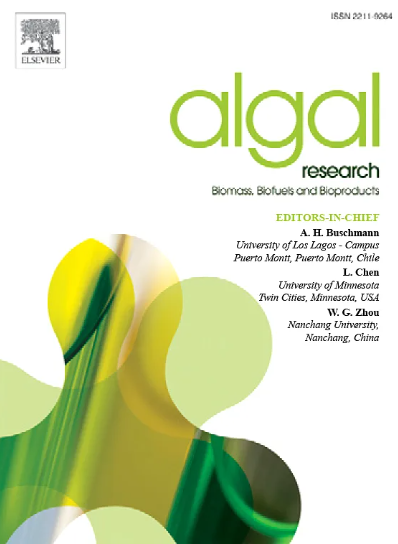Light and temperature culture conditions impact the metabolome of the cyanobacterium of therapeutic interest Planktothricoides raciborskii PMC 877.14
IF 4.6
2区 生物学
Q1 BIOTECHNOLOGY & APPLIED MICROBIOLOGY
Algal Research-Biomass Biofuels and Bioproducts
Pub Date : 2024-10-11
DOI:10.1016/j.algal.2024.103738
引用次数: 0
Abstract
Cyanobacteria are ancient photosynthetic microorganisms with a long evolutionary history that have adapted to inhabit diverse environments, such as thermal waters and muds. To do so, they are known to produce a wide range of bioactive molecules likely involved in adaptative traits such as high light and/or high temperature resistance mechanisms, which makes them particularly interesting for inclusion in thermal treatments and various therapeutic applications.
In this study, the impact of higher temperature and light intensity culture conditions on the metabolome of a promising cyanobacterial strain isolated from the muds of the Balaruc-les-Bains thermal station, Planktothricoides raciborskii PMC 877.14, was investigated through liquid chromatography and mass spectrometry analyses. Statistical analyses of the biological data and molecular network construction allowed for the exploration of potential metabolite induction under different culture conditions, in order to drive the production of specific metabolites aimed at coping with cellular stress. A global shift on intracellular metabolic composition was observed over time with increased biomass production. Higher light intensity was found to stimulate both growth and production of antioxidant and/or photoprotective molecules (such as ergothioneine, mycosporine-like amino acids or carotenoids) while an increase in temperature influenced the higher production of phycobilins (such as phycoerythrin and phycocyanin).
These results highlight the importance of culture/environmental conditions in driving intracellular metabolite differentiation and open up new perspectives in selecting of the optimal parameters for the growth and production of bioactive molecules for therapeutic applications in the cyanobacterium P. raciborskii PMC 877.14.
光照和温度培养条件影响治疗用蓝藻的代谢组 Planktothricoides raciborskii PMC 877.14
蓝藻是一种古老的光合微生物,具有悠久的进化历史,能够适应热水域和淤泥等各种环境。本研究通过液相色谱和质谱分析,研究了较高温度和光照强度的培养条件对从 Balaruc-les-Bains 热站淤泥中分离出的蓝藻菌株 Planktothricoides raciborskii PMC 877.14 代谢组的影响。通过对生物数据的统计分析和分子网络的构建,探索了在不同培养条件下可能诱导产生的代谢物,从而推动产生旨在应对细胞压力的特定代谢物。随着时间的推移,随着生物量的增加,观察到细胞内代谢组成发生了全面变化。研究发现,较高的光照强度既能刺激生长,也能促进抗氧化和/或光保护分子(如麦角硫因、类菌素氨基酸或类胡萝卜素)的产生,而温度的升高则会影响藻青素(如藻红素和藻蓝素)的大量产生。这些结果凸显了培养/环境条件在驱动细胞内代谢物分化方面的重要性,并为选择最佳参数以促进蓝藻 P. raciborskii PMC 877.14 的生长和生产用于治疗的生物活性分子开辟了新的前景。
本文章由计算机程序翻译,如有差异,请以英文原文为准。
求助全文
约1分钟内获得全文
求助全文
来源期刊

Algal Research-Biomass Biofuels and Bioproducts
BIOTECHNOLOGY & APPLIED MICROBIOLOGY-
CiteScore
9.40
自引率
7.80%
发文量
332
期刊介绍:
Algal Research is an international phycology journal covering all areas of emerging technologies in algae biology, biomass production, cultivation, harvesting, extraction, bioproducts, biorefinery, engineering, and econometrics. Algae is defined to include cyanobacteria, microalgae, and protists and symbionts of interest in biotechnology. The journal publishes original research and reviews for the following scope: algal biology, including but not exclusive to: phylogeny, biodiversity, molecular traits, metabolic regulation, and genetic engineering, algal cultivation, e.g. phototrophic systems, heterotrophic systems, and mixotrophic systems, algal harvesting and extraction systems, biotechnology to convert algal biomass and components into biofuels and bioproducts, e.g., nutraceuticals, pharmaceuticals, animal feed, plastics, etc. algal products and their economic assessment
 求助内容:
求助内容: 应助结果提醒方式:
应助结果提醒方式:


